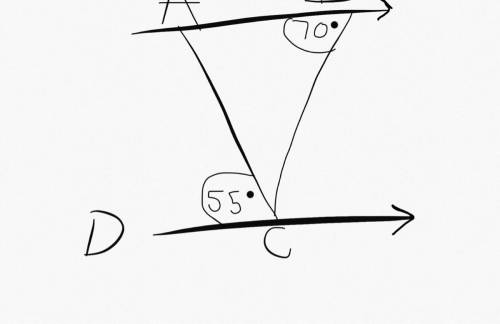In the diagram AB is parallel to DC.
Angle ABC = 70°
Angle ACD = 55°
Not drawn...

Mathematics, 11.03.2020 01:28 UncleVictor5188
In the diagram AB is parallel to DC.
Angle ABC = 70°
Angle ACD = 55°
Not drawn accurately
Show that triangle ABC is isosceles.
You must give reasons in your working.


Answers: 2


Other questions on the subject: Mathematics

Mathematics, 21.06.2019 13:00, domdom71
() (98 points)to be fair, you have to have a very high iq to understant the jokes in rick and morty. the humour is extremely subtle, and without a solid grasp of theoretical physics most of the jokes will go over a typical viewer's head. there's also rick's nihilistic outlook, which is deftly woven into his characterisation- his personal philosophy draws heavily from narodnaya volya literature, for instance. the fans understand this stuff; they have the intellectual capacity to truly appreciate the depths of these jokes, to realise that they're not just funny- they say something deep about life. as a consequence people who dislike rick & morty truly are idiots- of course they wouldn't appreciate, for instance, the humour in rick's existential catchphrase "wubba lubba dub dub," which itself is a cryptic reference to turgenev's russian epic fathers and sons. i'm smirking right now just imagining one of those addlepated simpletons scratching their heads in confusion as dan harmon's genius wit unfolds itself on their television screens. what fools.. how i pity them. and yes, by the way, i do have a rick & morty tattoo. and no, you cannot see it. it's for the ladies' eyes only- and even then they have to demonstrate that they're within 5 iq points of my own (preferably lower) beforehand. nothin personnel kid
Answers: 1


Mathematics, 22.06.2019 03:00, kittenlover5031
In this problem, we explore the effect on the standard deviation of multiplying each data value in a data set by the same constant. consider the data set 14, 6, 8, 15, 15. (a) use the defining formula, the computation formula, or a calculator to compute s. (round your answer to one decimal place.) s = 4.28 (b) multiply each data value by 3 to obtain the new data set 42, 18, 24, 45, 45. compute s. (round your answer to one decimal place.) s = 12.83 (c) compare the results of parts (a) and (b). in general, how does the standard deviation change if each data value is multiplied by a constant c? multiplying each data value by the same constant c results in the standard deviation remaining the same. multiplying each data value by the same constant c results in the standard deviation being |c| times as large. multiplying each data value by the same constant c results in the standard deviation increasing by c units. multiplying each data value by the same constant c results in the standard deviation being |c| times smaller. (d) you recorded the weekly distances you bicycled in miles and computed the standard deviation to be s = 3.8 miles. your friend wants to know the standard deviation in kilometers. do you need to redo all the calculations? yes no given 1 mile ≠1.6 kilometers, what is the standard deviation in kilometers? (enter your answer to two decimal places.)
Answers: 1

Mathematics, 22.06.2019 04:00, ttrinityelyse17
What is the approximate value of the correlation coefficient for the given graph? a. 1 b. 5 c. 3 d. -1
Answers: 2
You know the right answer?
Questions in other subjects:



Mathematics, 05.07.2019 11:10


Biology, 05.07.2019 11:10



Mathematics, 05.07.2019 11:10

History, 05.07.2019 11:10



